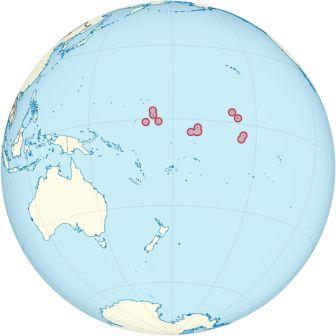Will Kiribati and other small Island states be lost to Climate Change?

The Island nation state of Kiribati was granted self-rule by the UK in 1971 and complete independence in 1979 under the new name of Kiribati. All of the islands are atolls (ring-shaped islands with central lagoons) except for the island of Banaba in the Gilbert Islands which is a raised limestone Island. Of the 33 islands of Kiribati, 21 are inhabited. Most of the population is concentrated in the Gilbert Islands and only one of the islands in Phoenix Group (Kanton Island) is inhabited and three of the Line Islands are permanently inhabited.
Climate Change has long been an issue for such island states which have even formed a union, the AOSIS (Alliance of Small Island States), a union consisting of island states that are most vulnerable to a rise in sea levels triggered by the changing climate.
Ioane Teitiota, 37, has asked for asylum in New Zealand on grounds of climate change. Teitiota who arrived in 2007 to New Zealand does not want to go back because there he does not see a future in his home country. Environmental refugees are not a new thing but the new class of climate change refugees is a closer possibility as global warming continues unabated.
As per the UNEP, environmental refugees are “those people who have been forced to leave their traditional habitat, temporarily or permanently, because of a marked environmental disruption (natural and/or triggered by people) that jeopardized their existence and/ or seriously affected the quality of their life. By ’environmental disruption’ is meant any physical, chemical and/or biological changes in the ecosystem (or the resource base) that render it temporarily or permanently, unsuitable to support human life.” (Environmental Refugees, Essam El-Hinnawi, UNEP, 1985)
Such forced migration has severe implications with the migrant population forced to live a life of penury initially, it is like rebuilding a life from scratch and migrants have to very often be satisfied with living a lower strata life in the new country.
As per the World Migration Report, 2013 by the International Organization for Migration, “The numbers of people moving as a result of environmental factors such as earthquakes, industrial accidents, floods, soil/coastal erosion and droughts, some of which may be related to climate change, are on the rise. Population movements induced by environmental factors tend to be predominantly internal.” Read the various reports by IOM here.
Kiribati has bought 2,200 acres of land in Fiji to act as a potential resettlement site for people displaced by the rising sea levels.
It is an extremely sad situation wherein you discover that one day you may not have a country of your own but that is the unfortunate reality and for nations like Kiribati, that possibility is not very far in future. The entire prospect is frightening. The world sadly is sleeping but if you sleep while your neighbour’s house burns down, yours would inevitably follow next.
Reference and further reading;
http://aosis.org/
http://uk.reuters.com/article/2013/10/16/us-newzealand-kiribati-climate-idUKBRE99F05A20131016

